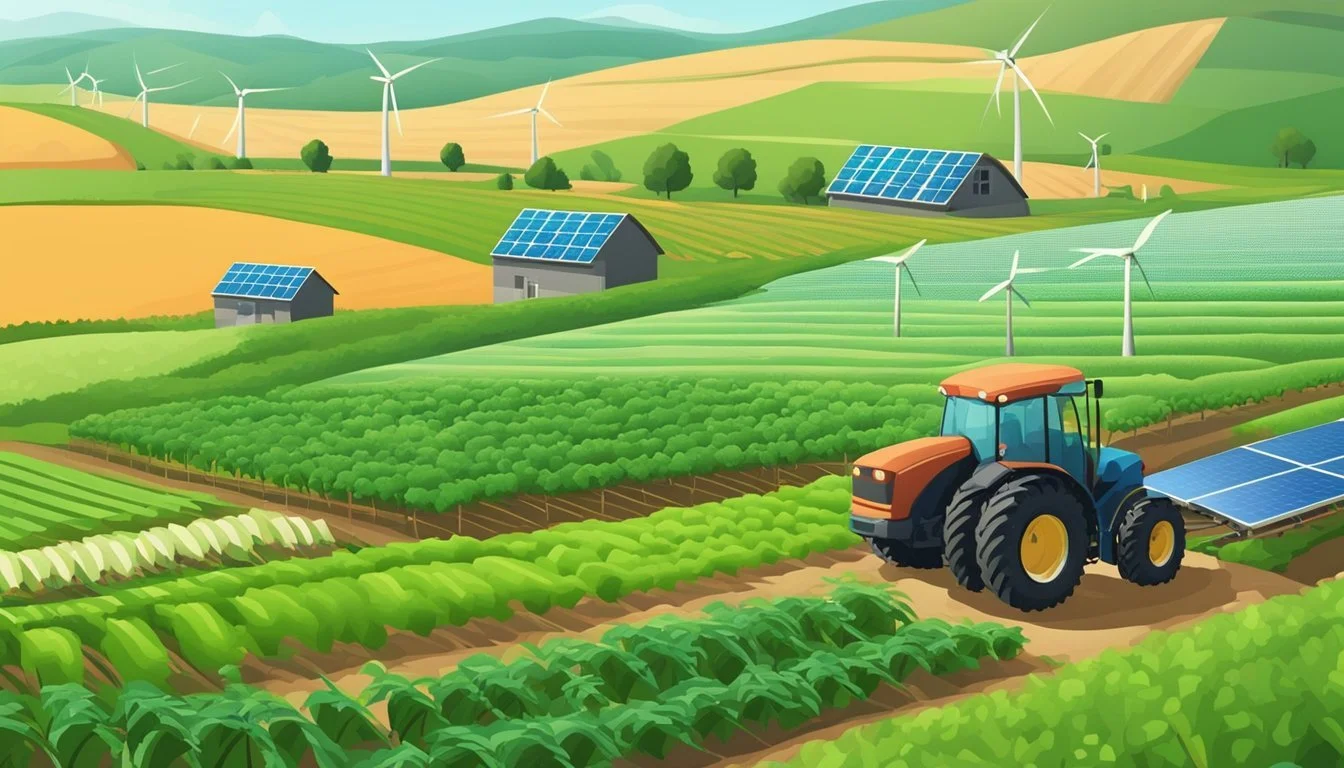Farm Loans in California
Navigating Financial Solutions for Agriculture
This Article is Part of Our Guide on Farm Loans for All 50 U.S. States
California's agricultural sector is pivotal to both the state's economy and the nation's food supply, ranking as one of the top agricultural producers globally. Access to capital through farm loans is a critical factor enabling the growth and sustainability of farms in the state. These financial instruments cater to a spectrum of needs, from starting new operations and purchasing land to covering operating expenses and capital improvements.
In the face of a complex and competitive market, a variety of loan programs are available to support California's farmers. State agencies like the California Infrastructure and Economic Development Bank offer programs partnering with lenders approved by the USDA's Farm Services Agency to guarantee loans. For those new to agriculture or looking to expand, the USDA Farm Service Agency provides Direct Farm Operating loans, which are essential in financing farm operations.
California also sees support from non-profit organizations such as California FarmLink, which, as a certified Community Development Financial Institution, focuses on serving underserved communities by providing fair and affordable loans aimed at agricultural and fishing businesses. With such diverse financial support systems in place, California agriculture benefits from resources tailored to foster growth, resilience, and innovation within the industry.
Understanding Farm Loans
Farm loans in California are instrumental in supporting the state's agricultural industry. They offer financial resources for farmers to acquire farmland, purchase livestock and equipment, and cover operating costs. Farm ownership loans enable the acquisition of property that can usher in new or expand existing farm ventures.
Operating loans, on the other hand, are the lifeblood of day-to-day farm functions. They facilitate the purchase of items necessary for the farm's operation—everything from seeds to feed for livestock. These loans stand as a gateway for farmers to maintain and strengthen their businesses.
Key Types of Farm Loans in California:
Direct Farm Operating Loans: Targeting especially the beginners in agriculture, these loans help cover the operational costs of running a farm.
Guaranteed Loans: Offered through participating lenders and sometimes backed by the U.S. Department of Agriculture, guaranteeing up to 90% of the loan.
Specialized Loans: For entities that focus on underserved communities, including non-profit lenders like California FarmLink, which emphasizes fair and affordable lending.
Loan Purposes:
Purchase of livestock and equipment
Procurement of seed and feed
Other operational expenses
In California, various programs aim to assist small and underserved farmers. This assistance ensures that every farmer has the opportunity to pursue success in agriculture, thereby contributing to the economic development of the state. It is essential for interested individuals to consult with approved lenders to understand eligibility, terms, and the application process.
Farm Loan Types in California
California offers a variety of farm loan types catered to the diverse needs of its agricultural sector. From operating costs to emergency relief, these loans are tailored to support the state's small to large-scale farming operations.
Operating Loans
Operating Loans provide essential capital for farmers to cover day-to-day expenses. These are commonly used for purchasing livestock, seeds, and equipment, or for covering immediate operating costs and living expenses during startup phases. Often, Operating Loans are fundamental for a farm's short-term financial health and sustainability.
Ownership Loans
Ownership Loans are designed for farmers seeking to purchase or expand their farmland. Under the category of Ownership Loans, there are Direct Farm Ownership Loans and Guaranteed Farm Ownership Loans, which may feature differing requirements like down payments. These loans are instrumental for long-term growth and development of farming operations.
Emergency Loans
When natural disasters strike, Emergency Loans offer a financial safety net for farmers. These loans assist in recovering from losses due to events like droughts, floods, or other natural calamities. Obtaining these loans promptly can be pivotal for the reconstruction and continuation of agricultural business.
Microloans
Microloans are a more accessible form of financial assistance, offering smaller, more manageable loan amounts. They cater specifically to smaller farms and niche producers, with requirements typically more relaxed than conventional agricultural loans. Maximum loan amounts can be as much as $50,000.
Youth Loans
Youth Loans serve young individuals actively engaged in agricultural projects. Available to youth aged 10-20, these loans aim to cultivate responsibility and support projects for organizations like 4-H or FFA. Loan amounts can be used for livestock, equipment, or project-based agricultural operations and typically have a cap amount that reflects the modest financial needs of youth-driven initiatives.
Eligibility and Requirements
Eligibility for farm loans in California involves specific criteria set by various programs, targeted to assist different groups of farmers based on experience, size, and circumstances of their farming operations.
First-time Farmers
Beginning farmers—those who have not operated a farm for more than 10 years—are encouraged through the Farm Service Agency's (FSA) Direct Farm Ownership Down Payment Loan. This loan requires applicants to participate in a program like 4-H clubs or FFA (Future Farmers of America) to ensure they are rooted in agricultural practices and leadership. Land tenure assistance is a focus of these loans, helping new farmers to purchase land and secure their agricultural future.
Small and Minority Farmers
Loans designed for small and minority farmers aim to support non-traditional and specialty operations. These farmers may access direct loans through the California Infrastructure Economic Development Bank's (IBank) Farm Loan Program. Small operations can further benefit from Microloans, a type of Farm Ownership Loan that is capped at $600,000 and is particularly suited for small, beginning, veteran, and minority producers.
Natural Disaster Assistance
For farm operators faced with the aftermath of a natural disaster, the FSA offers assistance to restore and rehabilitate agriculture operations. Eligible parties can use resources from farmers.gov and the Loan Assistance Tool to evaluate their qualification for disaster-related loans. These funds are essential for sustaining and recovering the agricultural landscape affected by unforeseen natural events.
Farmers are encouraged to utilize the Loan Assistance Tool available on the USDA's website for an efficient application process and to verify their personal eligibility against FSA's requirements.
Applying for Farm Loans
When a farmer or rancher in California seeks to apply for a farm loan, they typically start by gathering the necessary loan information and requirements. The application process can be initiated by contacting a service center that supports farmers, such as those run by USDA's Farm Service Agency (FSA) or approved lending corporations.
Enrollment in a loan program is not an instantaneous process, and applicants should be prepared to provide detailed financial, operational, and personal information. The USDA has a Farm Loan Discovery Tool, which potential loan applicants can use to identify the types of loans that may meet their needs before discussing the options with a loan officer.
Applicants should keep in mind the following key steps:
Contacting a Service Center: Initiate the process by finding the nearest USDA service center or participating lender.
Using the Discovery Tool: Utilize online tools to narrow down loan types.
Compiling Information: Collect financial records, farm operation details, and personal identification.
Meeting a Loan Officer: Schedule a consultation with a loan officer to discuss suitable loan options.
The USDA has worked to streamline the application procedures, making it more straightforward for applicants to understand and complete the requirements. However, it is critical for applicants to read all details and seek clarification whenever necessary.
To support the process, tables can be effectively used to summarize available loans:
Loan Type Purpose Minimum Credit Score Operating Loans Livestock, seeds, equipment, costs Varies by lender Ownership Loans Land purchase Varies by lender
By following these steps, California farmers can navigate through the intricacies of applying for farm loans with confidence.
Financial Planning and Management
Effective financial planning and management in agriculture are pivotal for the sustainability and growth of farms. Farmers must consider operating costs, negotiate interest rates and terms, and manage debt prudently.
Operating Costs
Operating costs for a farm include not only inputs like seeds and equipment but also family living expenses and labor costs. An operating loan can provide the necessary capital to cover these expenses, ensuring that farms maintain cash flow throughout the year. It is critical for farmers to closely monitor and adjust their budgets as costs fluctuate to remain financially sound.
Inputs/Supplies: Seeds, fertilizer, feed
Labor: Hiring workers, family living expenses
Maintenance: Equipment repair, infrastructure upkeep
Interest Rates and Terms
Interest rates and loan terms dictate the cost of borrowing and ultimately, the financial health of the farm. Farmers should seek out competitive farm loan rates and reasonable terms that align with their projected cash flow. California's agricultural lenders offer various options, but it's imperative to compare and understand the terms, such as fixed or variable rates and repayment schedules.
Fixed Rates: Provides stability against rate fluctuations
Variable Rates: Can offer lower initial rates but include risk of increase
Terms: Length of the loan repayment period
Debt Management
Debt management is crucial for maintaining a farm's financial stability. Farmers should leverage options like lines of credit wisely, ensuring that they can meet repayment obligations without jeopardizing the farm's operations. Regularly evaluating debt levels against income and making adjustments to repayment strategies when necessary helps in preventing financial strain.
Debt-to-Income Ratio: Keeping this in balance to ensure repayment capacity
Repayment Schedules: Aligning with farm’s cash flow patterns
Refinancing Options: Considering to reduce overall cost of debt
Resources and Support
Farmers in California have access to a variety of resources and support mechanisms aimed at facilitating financial and operational success. These include assistance from government agencies, educational programs, and online tools that cater to the diverse needs of the agricultural community, from securing loans to enhancing farm management practices.
USDA Farm Service Agency (FSA)
The USDA's Farm Service Agency (FSA) provides a range of farm loan options to aid farmers in starting, maintaining, and expanding their operations. Direct Farm Operating loans are particularly critical for new farmers, serving as a pathway into agricultural production with affordable financing options. The FSA also offers loan guarantees which can cover up to 90% of loan amounts through approved lenders, thus reducing the risk and encouraging lending to small farm operations in California.
Educational Programs
Educational agricultural projects in California aim to support farmers with training and development. These initiatives include workshops, courses, and seminars that cover various aspects of farming, from crop production to financial management. By participating in these programs, farmers can stay updated with the latest practices and innovations in the field, equipping them with the information needed to make informed decisions and enhance their farm's profitability.
Online Tools and Services
California farmers can benefit from online tools and services that offer convenience and accessibility. One such feature is the "Pay My Loan" tool, which facilitates easy online repayments of loans, saving time for busy farmers. This secure service is part of the broader support offered through the USDA and FSA's digital platforms, where farmers can also find application forms, loan information, and a wealth of other resources essential for farm management and financial planning.
Agricultural Practices and Sustainability
The sustainability of agriculture in California hinges on effective soil and water conservation, as well as sustainable livestock and crop production methods. These practices are vital for maintaining soil and water resources, and ultimately enhancing agricultural productivity in the state.
Soil and Water Conservation
Water Conservation: California's farmers implement drip irrigation and other efficient watering systems to maximize usage of limited water resources. Such systems reduce water wastage and ensure the distribution is targeted to the crops' root systems.
Soil Health: Cover crops, reduced tillage, and crop rotation are strategies that preserve the soil structure and reduce erosion. These methods help to maintain a healthy balance of nutrients and microorganisms in the soil, contributing to its long-term fertility.
Sustainable Livestock and Crop Production
Livestock Management: Sustainable livestock practices include rotational grazing, which preserves grassland habitats and allows soil recovery time. This practice supports water retention and soil health.
Crop Diversity: Diverse crop rotations and polycultures are cultivated not only to meet market demands but also to break pest and disease cycles, maintain soil fertility, and reduce dependency on chemical inputs.
Farmers in California recognize the responsibility they have towards the land and water resources they rely on. Through thoughtful management and adopting environmentally sound practices, they work toward a sustainable future for agriculture.
Insurance and Risk Management
Farmers in California contend with various risks, including natural disasters such as wildfires and severe droughts. A robust insurance and risk management strategy is essential for protecting their agricultural operations, livestock, and livelihoods.
Natural Disasters and Recovery Resources: Farmers facing losses due to natural disasters can seek assistance through programs like the USDA's Risk Management Agency, which partners with Approved Insurance Providers. These partnerships are tailored to ensure efficient loss adjustment and prompt claims payment processing. Assistance for recovery can also be accessed through programs that support farmers affected by events like wildfires.
Livestock Programs: For livestock producers, the Livestock Indemnity Program (LIP) provides benefits for livestock deaths in excess of normal mortality due to adverse weather. Additionally, the Livestock Forage Program (LFP) offers compensation for lost forage due to drought.
Tree Assistance Program (TAP): TAP becomes relevant for orchards and nurseries; it offers aid to eligible producers to replant or rehabilitate trees, bushes, and vines damaged by natural disasters.
Insurance for Fishers and Farmers: It is important that fishers and farmers assess their need for coverage to mitigate the financial impact of extreme weather and other unforeseen events affecting agricultural land and operations. Insurance products tailored to specific needs—ranging from crop insurance for farmers to fishing operations—are available.
Proactive Management: Investing in suitable insurance options enables farmers and fishers in California to manage risks proactively, ensuring their resilience and long-term productivity. They also benefit from financial tools and educational resources to understand and navigate the complexities of agricultural risk management.
Government Policies and Regulations
California's agricultural sector operates within a robust framework of government regulations intended to support sustainable farming practices and economic growth. These policies encompass various areas including necessary permits, tax incentives, and land use guidelines.
Permits and Licenses
Farmers in California must comply with a range of permits and licenses that regulate agricultural practices. For instance, the United States Department of Agriculture (USDA) provides services through its Farm Service Agency (FSA) to facilitate farming operations. These services include ensuring farmers have the appropriate authorization to legally operate. Additionally, specific programs like the Conservation Reserve Program (CRP) may require separate enrollment and compliance to environmental standards.
Tax Incentives
Tax incentives play a pivotal role in agricultural economics in California. They are a key part of government policies aimed at fostering a favorable environment for farming businesses. The USDA and the state of California provide various tax relief options and credits, especially for activities that promote conservation and sustainable agriculture. The federal Farm Bill periodically adjusts these incentives to reflect current economic and agricultural conditions, offering opportunities for farmers to benefit financially from adhering to specified guidelines and protocols.
Land Use Regulations
Land use regulations are critical in managing California's agricultural landscape. The government enforces specific zoning laws that determine how land can be used for agricultural versus non-agricultural purposes. Moreover, when it comes to land loans, the USDA's Guaranteed Farm Loan programs support farmers by providing capital to acquire land. These loans are attached to policies and regulations that ensure the land is used for specified agricultural objectives, maintaining compliance with environmental and economic standards.
Government policies and regulations in California are designed to balance the needs of agricultural advancement with environmental stewardship and economic sustainability. Permits and licenses, tax incentives, and land use regulations are three key areas where this balance is executed.
Market Trends and Economic Impact
California's agricultural sector plays a pivotal role in both the state and the global market, leading in a variety of commodities. In recent years, agricultural exports rose by 7.0 percent, amounting to $22.5 billion in 2021. Vital exports include a diverse set of commodities such as almonds, dairy products, pistachios, wine, and walnuts.
Fruits and Vegetables: California dominates in production, driving considerable market trends and economic impacts.
Nuts: A leading commodity, particularly almonds and pistachios, showing strong demand and export growth.
Milk: As a significant exporter, California’s dairy industry directly influences market trends.
The state's substantial economic contributions are also evident in agricultural cash receipts, where California ranked as the top state in 2020. The ripple effects on the economy are expansive, with agricultural producers greatly influencing overall economic health.
Concerning market trends, demands for sustainable farming practices and organic produce are shaping how producers approach agricultural production. The presence of state-led farm loan programs reflects an acknowledgment of the need to support small farms, crucial for sustaining the industry's growth and addressing market demands.
To summarize, California's agriculture has a direct and sizable economic impact. The state's innovation in cultivation and production practices continues to keep it at the forefront of meeting both domestic and international market needs. As of current data, the agriculture sector remains a cornerstone of California's economic structure, with a proven track record of resilience and adaptation to changing market trends.
Disaster Recovery
In the face of natural disasters, such as winter storms and flooding, California's family farmers have access to vital financial aid through emergency loans and disaster assistance programs. These emergency loans are often low-interest and aim to help recover from production and physical losses.
Emergency Loans: Offered by the USDA, these loans help producers in disaster-designated counties. The funds can be used for restoration and to sustain farm operations.
Disaster Assistance: Programs under USDA provide various forms of relief. Notably, assistance is extended to those affected by wildfires and severe droughts. Here's a brief overview:
Direct Assistance: For immediate relief, farmers can apply for direct support through USDA's Farm Service Agency (FSA).
Guaranteed Loans: Loans through FSA can be guaranteed up to 90%, with participating lenders offering necessary financial help.
Eligibility:
Presence in a county with primary or contiguous disaster designation.
Substantial production and physical losses due to disaster events.
It is imperative for affected family farmers to reach out to the FSA to determine their eligibility for these programs. Additionally, webinars and tools like the Disaster Assistance Discovery Tool offer more detailed guidance on available aid.
Organizations such as California FarmLink provide non-profit lending, focusing on underserved communities, further supporting recovery efforts. Their goal is to facilitate fair and affordable access to credit, thereby enhancing the resilience of agricultural and fishing businesses post-disaster.
Advancement Opportunities
Farm loans in California offer a range of opportunities for those who are starting or expanding their agricultural projects. Beginning farmers and ranchers have access to specialized programs aimed at helping them initiate and grow their operations. For instance, Farm Operating Loans and EZ Guarantee Programs are structured to cater to the unique needs of small, niche, and non-traditional farm operations, including those involved in direct farmers market sales and Community-Supported Agriculture (CSA).
Educational agricultural projects can benefit from loans aimed at increasing agricultural productivity and foster learning. The programs often serve as a crucial resource in helping new entrants learn the ropes of farming, managing finances, and becoming successful owner-operators.
Additionally, the Farm Storage Facility Loan program provides affordable financing to producers to build or upgrade farm storage and handling facilities. This is an essential step for farmers who want to ensure that their commodities are stored safely and efficiently, thus improving their marketability and helping to stabilize their income.
Facility Type Usage Cold Storage For perishable commodities Grain Bins For grain storage Structures for Wood Pellets For renewable energy commodities
The loan terms vary, thus offering flexibility, and the interest rates are typically favorable to support long-term sustainability and profitability of farming ventures in the state. These loan programs collectively provide a robust structure for supporting the agricultural ecosystem in California, fostering advancement and economic development in both rural and urban farm settings.
Capital Improvements and Expansion
When investing in capital improvements and expansion in the agriculture sector of California, farmers and ranchers can access a variety of loans tailored to meet their needs. These capital infusions can be pivotal for the enhancement of farm infrastructure, purchasing new land, and covering various associated closing costs.
Farm Infrastructure: Functional improvements such as irrigation systems, storage facilities, or renewable energy installations are essential in modernizing farms and increasing productivity.
Land Expansion: Acquiring additional acreage can lead to increased crop yields and livestock production. Expansion facilitates economies of scale, which can lead to greater competitiveness in the market.
Capital Improvements: Upgrades or additions that add value to the property, improve operations or comply with regulatory standards are common uses for loan proceeds.
Loans aimed at these purposes usually come with criteria for employment generation or conservation, ensuring that the investment also contributes to local community development and sustainable practices.
Here's a brief overview of funds allocation:
Use of Funds Type of Expense Infrastructure Storage, Energy Solutions, Water Systems Land Purchase Acquisition of Additional Farmland Capital Improvement Construction, Technology Upgrades Closing Costs Legal Fees, Transactional Expenses
Entities such as the California Infrastructure Economic Development Bank, California Coastal Rural Development Corporation, and specialized non-profit lenders like California FarmLink, provide a financial runway for these critical investments. These lenders offer tailored products with a focus on underserved communities, often collaborating with institutions like the USDA to provide flexible and fair loan terms.
It is important for farmers to consider both the short-term and long-term impacts of these loans, ensuring they align with their business growth strategies and operational goals.














